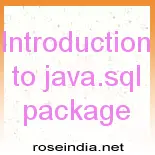Introduction to java.sql package
This package provides the APIs for accessing and processing data which is stored in the database especially relational database by using the java programming language. It includes a framework where we different drivers can be installed dynamically to access different databases especially relational databases.
This java.sql package contains API for the following :
1 Making a connection with a database with the help of DriverManager class
a) DriverManager class: It helps to make a connection with the driver.
b) SQLPermission class: It provides a permission when the code is running within a Security Manager, such as an applet. It attempts to set up a logging stream through the DriverManager class.
c) Driver interface : This interface is mainly used by the DriverManager class for registering and connecting drivers based on JDBC technology.
d). DriverPropertyInfo class : This class is generally not used by the general user.
2). Sending SQL Parameters to a database :
a). Statement interface: It is used to send basic SQL statements.
b). PreparedStatement interface: It is used to send prepared statements or derived SQL statements from the Statement object.
c). CallableStatement interface : This interface is used to call database stored procedures.
d). Connection interface : It provides methods for creating statements and managing their connections and properties.
e). Savepoint : It helps to make the savepoints in a transaction.
3). Updating and retrieving the results of a query:
a). ResultSet interface: This object maintains a cursor pointing to its current row of data. The cursor is initially positioned before the first row. The next method of the resultset interface moves the cursor to the next row and it will return false if there are no more rows in the ResultSet object. By default ResultSet object is not updatable and has a cursor that moves forward only.
4.) Providing Standard mappings for SQL types to classes and interfaces in Java Programming language.
a). Array interface: It provides the mapping for SQL Array.
b). Blob interface : It provides the mapping for SQL Blob.
c). Clob interface: It provides the mapping for SQL Clob.
d). Date class: It provides the mapping for SQL Date.
e). Ref interface: It provides the mapping for SQL Ref.
f). Struct interface: It provides the mapping for SQL Struct.
g). Time class: It provides the mapping for SQL Time.
h). Timestamp: It provides the mapping for SQL Timestamp.
i). Types: It provides the mapping for SQL types.
5). Metadata
a). DatabaseMetaData interface: It keeps the data about the data. It provides information about the database.
b). ResultSetMetaData: It gives the information about the columns of a ResultSet object.
c). ParameterMetaData: It gives the information about the parameters to the PreparedStatement commands.
6). Exceptions
a). SQLException: It is thrown by the mehods whenever there is a problem while accessing the data or any other things.
b). SQLWarning: This exception is thrown to indicate the warning.
c). BatchUpdateException: This exception is thrown to indicate that all commands in a batch update are not executed successfully.
d). DataTruncation: It is thrown to indicate that the data may have been truncated.
7). Custom mapping an SQL user- defined type (UDT) to a class in the java programming language.
a). SQLData interface: It gives the mapping of a UDT to an intance of this class.
b). SQLInput interface: It gives the methods for reading UDT attributes from a stream.
c). SQLOutput: It gives the methods for writing UDT attributes back to a stream.



